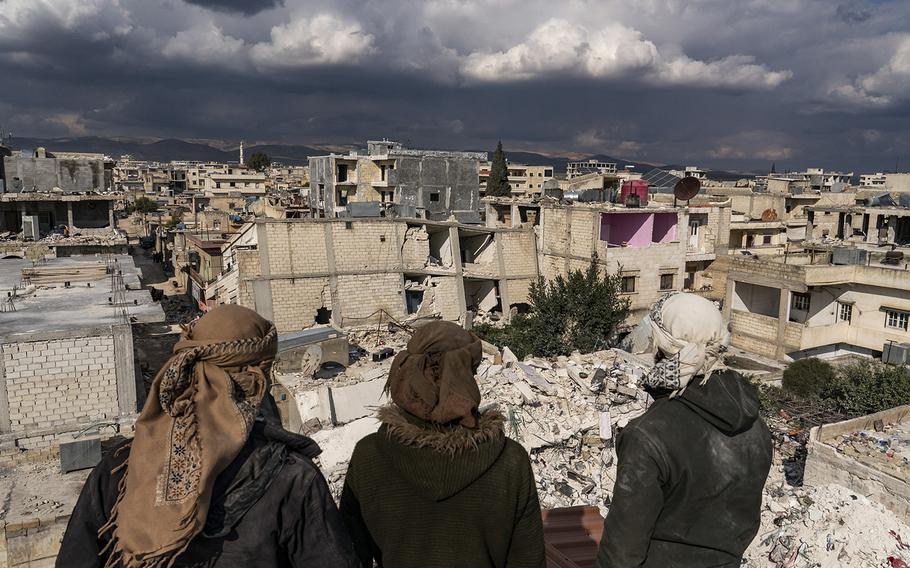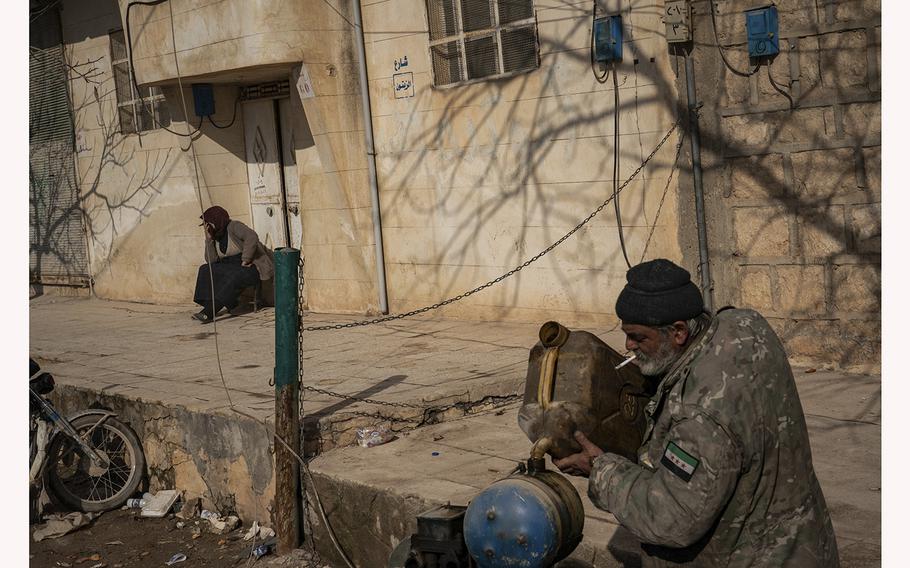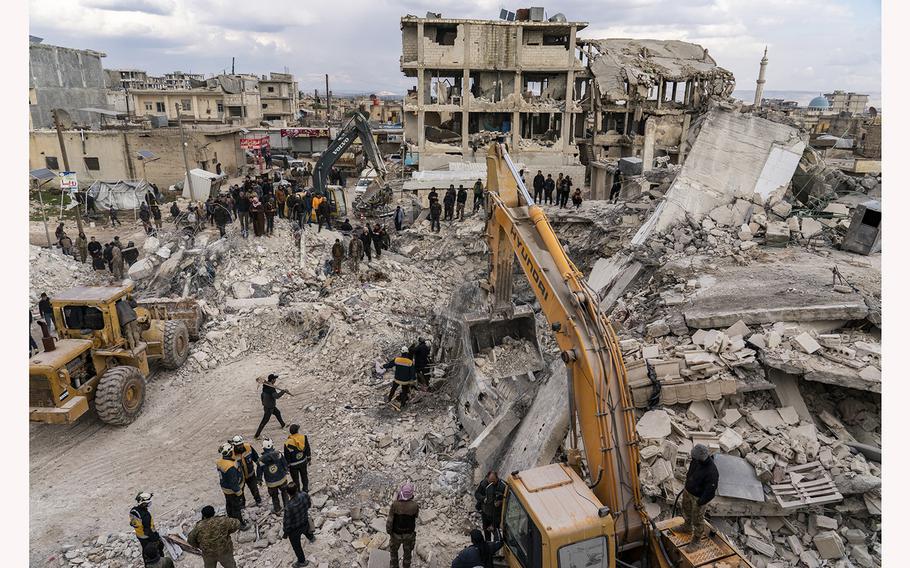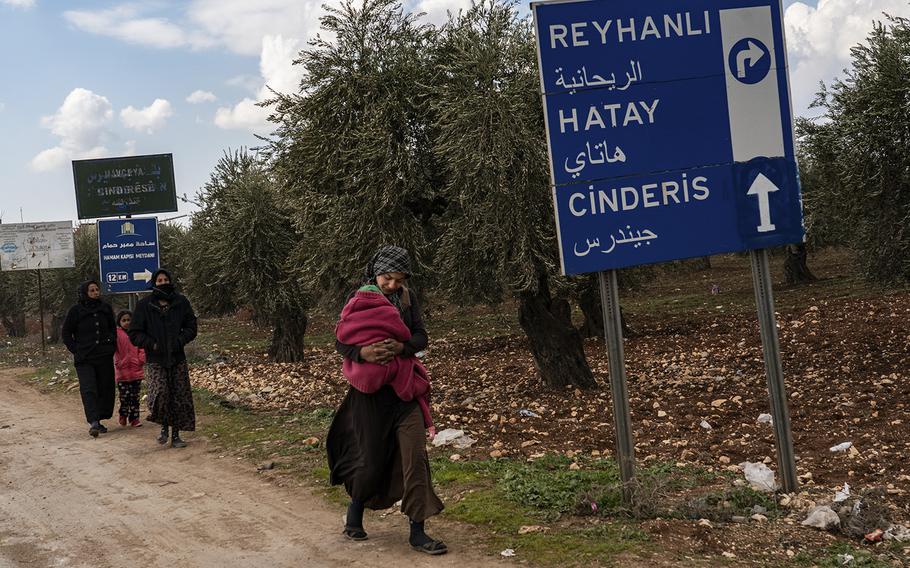
Locals from neighboring villages who came to Jinderis, Syria, to help view the destruction on Friday, Feb. 10, 2023, caused by major earthquakes. (Salwan Georges/Washington Post )
JINDERIS, Syria - It took four days and nights after the earthquake for the rubble to fall silent here. The strongest voices belonged to the women, residents said. Parted from their children, or fighting to save them, they screamed until their lungs gave out.
In this forgotten pocket of rebel-held northwest Syria, there were no international rescue workers to save them. No aid shipments brought painkillers to the survivors when stocks ran low. Just six miles away, across the border in Turkey, thousands of tons of relief poured in; support teams from as far away as Taiwan answered the Turkish government's call for help. But Syria, divided against itself and isolated from much of the world, was left to pick up the pieces alone, as it has again and again over more than a decade of war and dislocation.
In the shattered town of Jinderis, at least 850 bodies had been recovered by Friday morning. Although hundreds are still missing, few believed there were any lives left to save. "We needed help here, we asked for help here," said the town's mayor, Mahmoud Hafar. "It never came."
On Friday, the Bab Al-Salama border crossing into Syria was almost empty. A single ambulance with flashing lights was waiting to enter. The only Syrians crossing back were those being returned to their families in body bags.
On a rare visit to this Syrian enclave, controlled by Turkish-backed armed groups, The Washington Post found communities gripped by shock and bewilderment, and very much alone. In Jinderis, fathers stood watch over the remains of their homes and told of waking up to find their wives and children dead. As hulking excavators clawed the rubble, searching for a 13-year old boy, a man asked reporters to help him contact the United Nations for help. "Maybe they don't know what happened in Jinderis," he said. "No one could see this and not come here."

A man fills a generator with gasoline near the town of Jinderis, Syria, on Friday, Feb. 10, 2023. (Salwan Georges/Washington Post )
This part of Syria has endured crisis after crisis, home to millions of people who have braved war and displacement, hunger and disease. Even before the earthquake, 4.1 million here required humanitarian assistance.
Access to areas outside of government control has been weaponized throughout the conflict by President Bashar al-Assad, who has imposed restrictions on the movement of humanitarian groups - he has been helped by allies like Russia at the United Nations, and, at times, by neighbors like Turkey and Jordan, who have periodically obstructed the flow of aid. United Nations officials have rarely complained publicly, a move critics argue is designed to maintain access to Damascus at the expense of millions of civilians living outside of Assad's control.
In Sawran, a small town 10 miles from the Turkish border, residents recalled the roar of the earthquake, so loud it seemed like the ground was snarling. As buildings crumbled, residents remember crying out to the heavens. Thirty-six people were killed, and 20 more injured.
News soon reached the survivors about what had happened 40 miles away, in Jinderis.
"We heard that Jinderis was the worst," said 21-year-old Mohammed Jassim, who went to assist in the rescue effort after learning that his aunt, her husband and their children had been killed in their home there. "They said there were hundreds under the rubble and they didn't have the equipment to help them."
All day, he heard the cries. There were scratches on his hands from clawing at the earth. "Imagine still crying out after four days," he said, and his expression turned hollow. "It's unimaginable. Everyone died."

White Helmet rescue workers dig through rubble for the body of a 13-year-old boy and others on Friday, Feb. 10, 2023, after a building collapsed in the town of Jinderis, Syria. (Salwan Georges/Washington Post )
With battle lines largely static after 12 years of grinding war, Syria's northwest has become a final refuge for millions of civilians or former fighters who fear for their safety if they return to government areas. Many of the original inhabitants remain, too poor to go elsewhere, even as the conflict closed in on them.
Jinderis, in particular, had escaped the worst excesses of the fighting for large periods, until Turkish-backed armed groups pushed Kurdish forces from the area in 2018.
Zakaria Tabakh, 26, came here from Aleppo, a city so pulverized by Assad's barrel bombs and airstrikes that whole swaths of it are still in ruins. He built a new life in Jinderis, marrying and having two children. He had put their two year old, Abdulhadi, to bed on Sunday night, laying awhile with the child before slipping out to sleep with his wife. He remembers only fragments of what followed. She was dead beneath the duvet. Abdulhadi died where he had been put down for the night. Rubble was everywhere.
Tabakh said that their funerals were sparsely attended: "Everyone is busy with their own cases."
The United Nation's migration agency said Friday that it had dispatched 14 trucks of humanitarian aid to rebel-held Idlib, the second such delivery since the earthquake. In Jinderis, the only visible aid distribution came from local charities - plastic bags of food and blankets piled on the back of flatbed trucks.
The death toll in rebel-held areas stands at more than 2,000, a far cry from the 20,000 killed in Turkey. But there are still many buildings to comb through, many people still unaccounted for.

Locals walk miles away from their town in Jinderis, Syria, on Friday, Feb. 10, 2023, after their homes were destroyed by major earthquakes. (Salwan Georges/Washington Post )
Rescue workers and residents were painfully aware that the only equipment available to them - mostly shovels and battered backhoes - were at times hurting the people they were trying to save. "How can you use these to conduct such delicate operations? You can't. It's impossible," said a member of the area's White Helmets civil defense force. "People have died in there because we don't have the equipment."
The White Helmets's director, Raed Saleh, said Friday that international aid, when it arrived, would come too late to help find survivors, and would go toward the removal of broken buildings.
The area's health facilities were hanging by a thread long before Monday's earthquakes. Assad's forces and their Russian allies systematically bombed health facilities, forcing hospitals underground as doctors fled. On Monday morning, the tidal wave of casualties pushed remaining facilities to the breaking point. In the town of Afrin, doctors estimate that around 70 percent of the patients they saw came from Jinderis.
"We had to refer many of them for amputations," said an emergency nurse, Ahmed Saqar, 53, on the phone. Without backup, his team was exhausted - survivors and saviors at the same time, one colleague said.
They need a break. Everyone does.
As darkness beckoned and the temperature dipped toward freezing, surviving residents were camped in the olive groves, some of them homeless now, others fearing their houses may still crash down. By nightfall, the fires they were burning from the olive branches would be the only light they had left.
Salwan Georges in Jinderis, Mustafa Salim in Baghdad and Claire Parker in Washington contributed to this report.